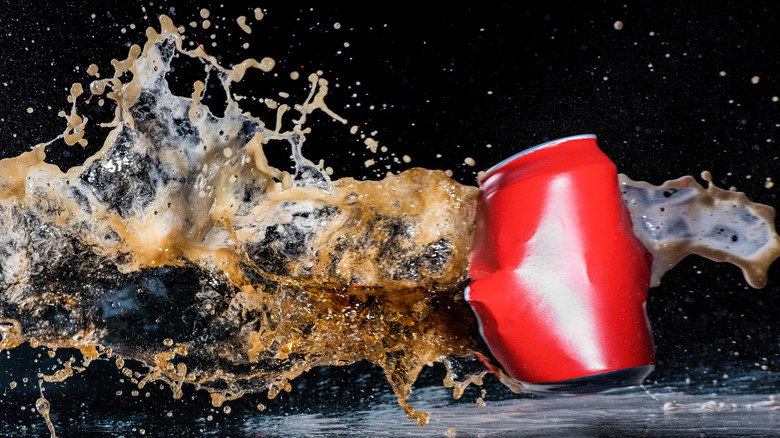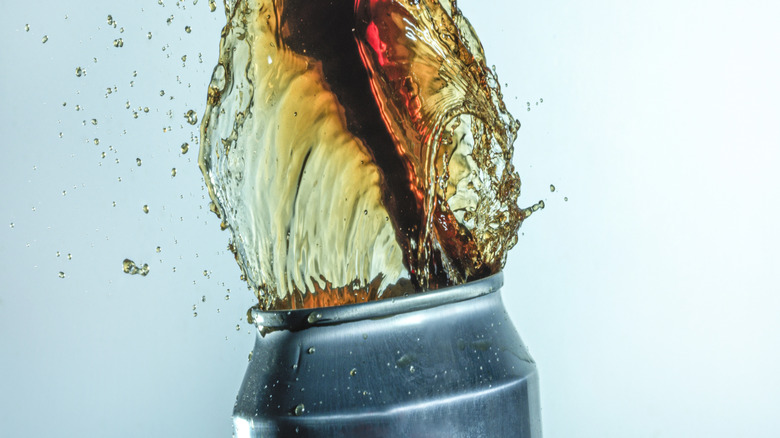A Strange Thing Happens When You Open A Shaken Soda Can On The Ocean Floor
It happens to the best of us. A can (or bottle) of soda gets shaken up, and once you pop the top, the beverage and bubbles spray out. It can make a real mess all over the counter, the floor, and your clothes and hands. If that's what happens above ground, have you ever considered what would happen if you shook and opened a soda can on the ocean floor? Perhaps you've been curious about sodas exploding in the freezer or Mentos making sodas explode. Opening a shaken can on the ocean floor is a much more niche experiment, but famous Canadian astronaut Colonel Chris Hadfield has the answer.
In 2010, Hadfield joined the 14th expedition of NASA Extreme Environment Mission Operations in the Aquarius Laboratory, which is 19 meters (about 62 feet) below the surface of Florida's coastal waters. The objective was to simulate space missions, study behavioral health, assess the immune system, and more. But, it wasn't all work and no play. In a YouTube video posted by Rare Earth — an account overseen by Hadfield's son, Evan — the astronaut tells the audience not to shake up their sodas at home because of the impending explosion of pop. He's shaking up a can of Coca-Cola as he talks and winces as he goes to pull the tab forward, and ... nothing happens. Hadfield proceeds to take a sip and says, "Ah, got a nice little fizz to it. It's all right. There you go. One of the advantages of living under the ocean."
Why a shaken can of soda doesn't explode underwater
Understanding why nothing happened when Hadfield opened the shaken Coca-Cola while living on the ocean floor requires knowing why soda explodes when shaken above water. As you likely know already, making soda fizzy is one of the uses of carbon dioxide gas. The cans (and bottles) are pressurized as the gas is added, which raises the solubility of the CO2 and allows it to dissolve into the liquid. Then, the gas in the soda and the remaining gas above the soda settle at a chemical equilibrium, which simply means that the rates of CO2 dissolving in and releasing from the liquid are equal.
Since the pressure inside the can (about 250 kPa) is greater than the atmospheric pressure (about 100 kPa), an imbalance occurs upon breaking the seal. The drop in pressure lowers the solubility of the CO2, causing it to effervesce out of the soda in the form of fizzy bubbles, which is why soda goes flat after a while. When you shake the can before opening it, though, the CO2 above the soda doesn't have anywhere to go because the liquid is already saturated. Instead of dissolving into the liquid, bubbles form. When the seal is broken, the dissolved CO2 effervesces from all the surface area available to it, and the added surface area inside the bubbles means that the dissolved gas can escape more rapidly. This reaction is what makes the soda "explode" out of the can in the form of foam.
At about 62 feet under the ocean's surface however, the Aquarius Laboratory experiences about 2.5 atmospheres of pressure, so anyone and anything in the lab experiences about 2.5 times the pressure of sea level. This higher atmospheric pressure, which is approximately equal to the pressure inside the can, means there is no pressure imbalance when the can is opened, therefore the solubility of the gas never changes, preventing an explosion of foam even after shaking the soda. Another happy consequence of this balance in pressure is that the fizz on the soda lasts longer, too.

